In the Parrish Perspectives exhibition “Joe Zucker: Life & Times of an Orb Weaver,” the Parrish Art Museum is showing drawings, prints and constructed paintings of spiders and their webs, imagery a bit more mainstream than one might imagine at first glance.
Why do we call the internet “the Web,” as in spider web? Born as the “hypertext stack” perhaps that nomenclature wasn’t catchy enough, and “hypertext browser” even less so. But World Wide Web, the image of an expanding spider web, held the conceptual cachet that did the trick for those pioneering computer scientists.
For all the arachnophobia apparent in the world, designers and artists refer to the sailors of the air and their sticky nets about as regularly as we see the wee creatures weaving silk on the living room ceiling, if not more often. This is especially true in the art world, with images of arachnids almost a genre unto themselves.
.
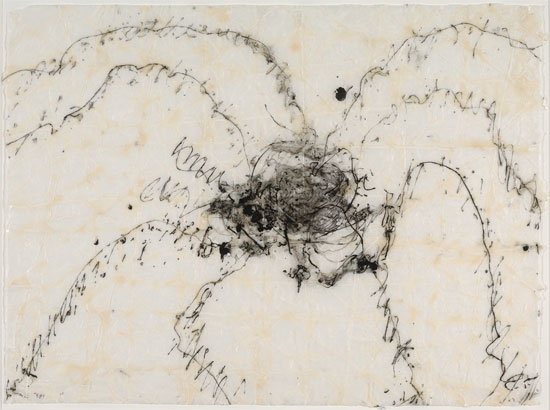
"Spider" by Joe Zucker, 1991. Acrylic on Japanese Rice Paper, 17 3/4 x 24 inches. Parrish Art Museum, Water Mill, New York, Gift of Julia Childs Augur, 2014.10.5.
.
The late Louise Bourgeois (1911-2010) got nicknamed Spiderwoman for the massive steel and bronze sculptures of spiders she began late in life. These became a museum hit and herculean versions up to 30 feet tall grace the front of Guggenheim Museum in Bilbao and the Mori Art Museum in Tokyo, among many others. Their elephantine proportions are intimidating, suggesting the notion that had evolution gone another way a very different kind of web might covering and connecting the world.
.

Sculpture by Louise Bourgeois at the Guggenheim Museum – Bilbao.
.
Interviews with Bourgeois have her portraying spiders as her protector, similar to her mother, because they ensnare insects that would otherwise feast on us.
The Viennese/Croatian design collective Numen/For Use builds giant webs as installations constructed humorously of packing tape. These webs are currently installed around the globe, inviting attendees to climb into the structure and experience what it feels like to be prospective dinner for a predator. Major installations of these sticky structures are in place in Melbourne, Paris, Tokyo, and Vienna among others.
.
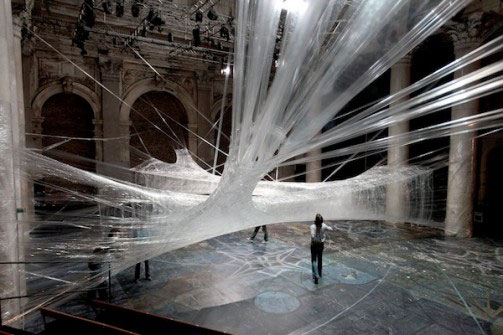
For Use/Numen installation.
.
Joe Zucker has more modest use for spiders and their tools, affixing them to rectangles, sometimes as etchings and sometimes as constructed paintings. It was the latter that he became known for, as much of his work is created by sculptural chance rather than a dauber rendering a layered image. He says appropriately that he is interested in creating an object instead of an illusion of one. It’s fitting that this sculptor-painter crossover should investigate this imagery, and the concept of object over illusion often emerges as a spider web.
For his “Empire Descending a Staircase,” a 2013 show at Mary Boone Gallery in New York, cribbing a title from Marcel Duchamp’s Nude Descending a Staircase (1912), Zucker again proved to be the ultimate idiosyncratic formalist. His constructed paintings as spider webs, shown at Boone and in a 1992 exhibition at the Parrish, came out of a 1970s movement of sculptured three-dimensional paintings that devalued the centuries’ long culture of layering paint and creating an illusion of space.
This practice became known for awhile as “post-minimalism,” pioneering a new linguistic oddity of describing new things as not the thing that came before, as in post-modernism, post-punk, post-feminism and so on. In the morning, I’m taking my car to Joe’s Garage because it’s post-running.
Why Zucker, Craig Kaufmann, Ed Moses, and the many others who labored similarly to trump painting didn’t simply become sculptors and classify image illusion as a separate craft and culture is a historical puzzle. They declined to drop the napkin in their lap ahead of the appetizer and work the forks from the outside in, but simultaneously refused to leave the table.
Perhaps they viewed this quest, and there were a lot of artists who joined them, as a brave new frontier of modernist reduction. There is still respect in the art world for this older crowd but, tellingly, younger artists who attempt to add to this subculture have been dubbed “Zombie Formalists.”
The Parrish Perspectives show currently on view has several constructed 60-inch square paintings in which the artist has tried his hand at building webs from sash cord and painters’ gel. Layers upon layers of gel build up a translucent image between a lattice of cord and situate the painting in the aforementioned constructed painting movement. He repeated the image over and over, apparently trying to get it just right. Beyond the characteristics of a spider’s web, its light brown color and waxy surface make viewing it seem like looking at a honeycomb.
.
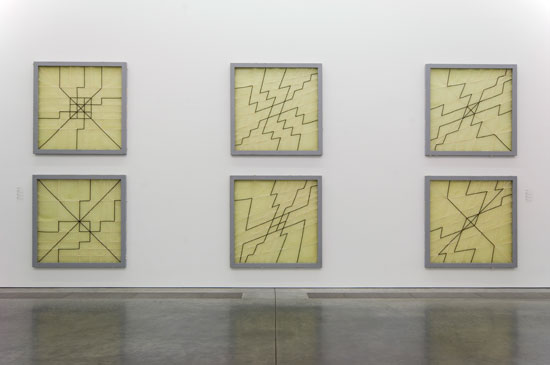
Installation view of the Parrish Art Museum exhibition "Joe Zucker: Life and Times of an Orb Weaver." All works by Joe Zucker (American, born 1941), 1991. (left to right, top to bottom) "Spider #3A," Courtesy Mary Boone Gallery, New York; "Spider #3," Private Collection, New York; "Spider #1," Courtesy Mary Boone Gallery, New York; "Spider #2A," Collection of Brenda Richardson, Baltimore; "Spider #4A," Courtesy Mary Boone Gallery, New York; "Spider #4," Courtesy Mary Boone Gallery, New York. Photo: Gary Mamay.
.
In Zucker’s prints in the exhibition the viewer does see image illusion and some depth.
A standout of the print series is the 1991 Spider Chronicles, the image of a spider drawn atop the trading results of the New York Stock Exchange. The image is self-explanatory and seems like a 1930s book cover by C.S. Lewis or some other writer spilling ink on the robber barons of early America. It is rendered abstractly, apparently with something other than a brush or pen or some other graphic tool, and had it not eight legs if would seem an abstract painting rather than a spider affixed to a financial page from the New York Times.
Other works are giddy and joyful and show the side of Zucker rarely seen: that of a cartoonist, somewhat in the vein of Red Grooms perhaps, but certainly a welcome aside from the more serious subjects at hand. Black Morse Code Web might have something to do with African-Americans or might not, “photo” credits were given as Raid Yomama and one image is of a spider being lynched. It’s too off the wall for this reviewer to make much of it.
.
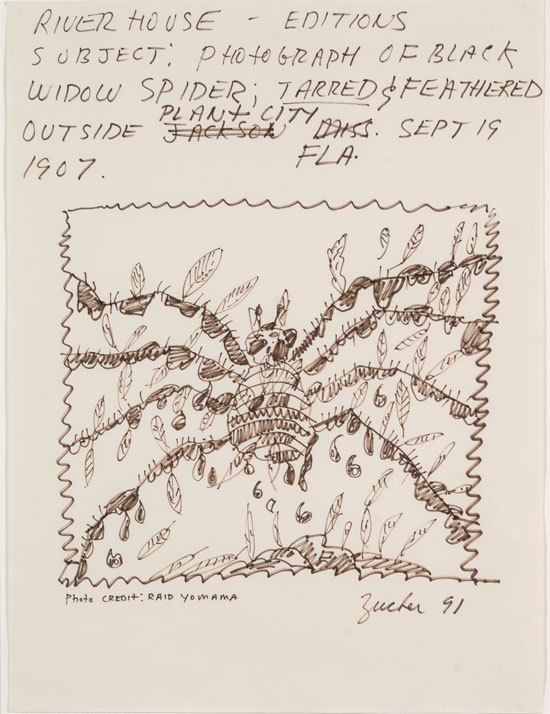
"Subject: Photograph of Black Widow Spider: Tarred & Feathered Outside Plant City, FLA, Sept 19, 1907 (Riverhouse Editions Project)" by Joe Zucker, 1991. Felt-tipped pen on paper, 24 x 18 inches. Parrish Art Museum, Water Mill, New York, Gift of Julia Childs Augur, 2014.10.9.
.
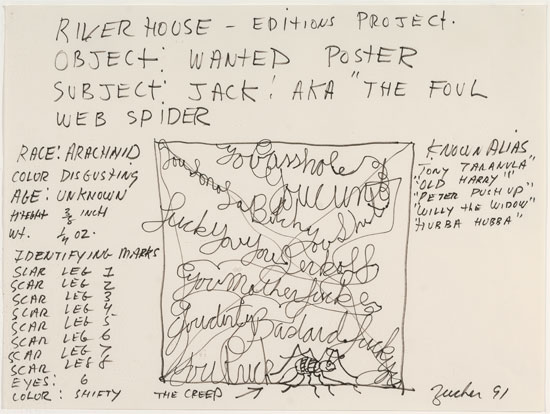
"Object: Wanted Poster; Subject: Jack! AKA "The Foul Web Spider" (Riverhouse Editions Project)" by Joe Zucker, 1991. Felt-tipped pen on paper, 18 x 24 inches. Parrish Art Museum, Water Mill, New York, Gift of Julia Childs Augur, 2014.10.2.
.
Nine of the exhibited drawings are a recent gift to the Parrish Art Museum and were taken from a print project by Riverhouse Editions in Colorado. Most of the shown work is dated 1991 and since the Parrish did the aforementioned previous show of Joe Zucker in 1992, along with Per Kirkeby, “Joe Zucker: Life & Times of an Orb Weaver” has a walk down Jobs Memory Lane feel to it.
BASIC FACTS: “Parrish Perspectives Joe Zucker: Life & Times of an Orb Weaver” remains on view through April 26, 2015 at the Parrish Art Museum, 279 Montauk Highway Water Mill, NY 11976. www.parrishart.org.
__________________________________
Copyright 2015 Hamptons Art Hub LLC. All rights reserved.
